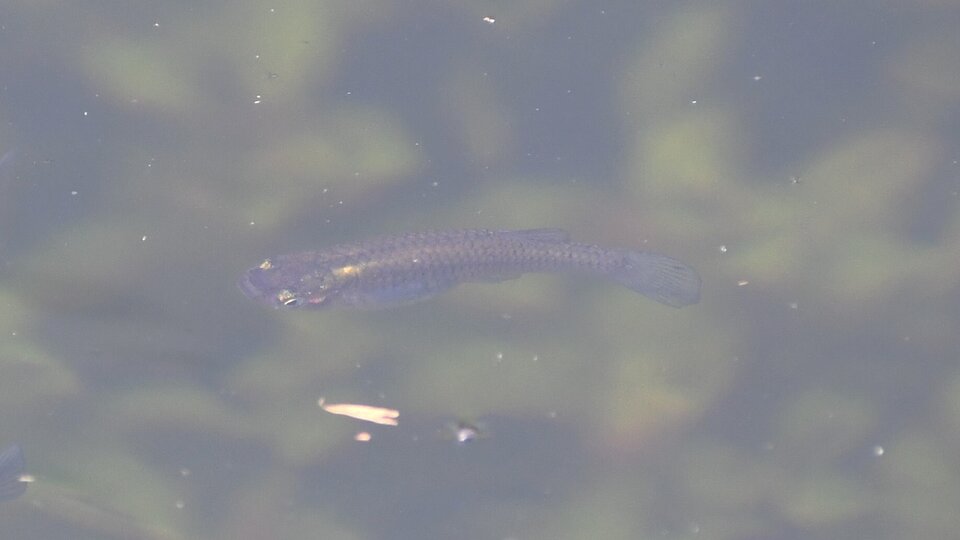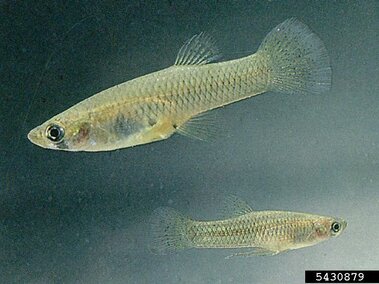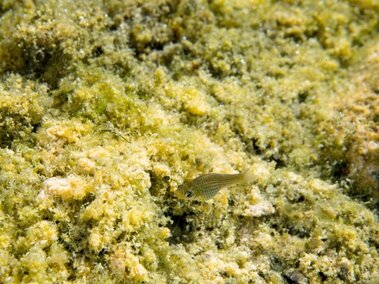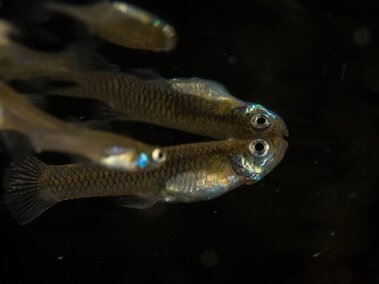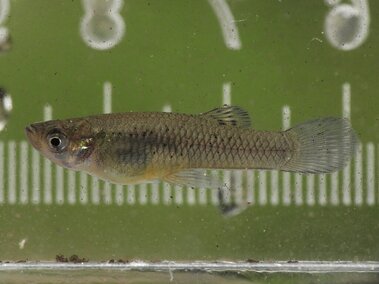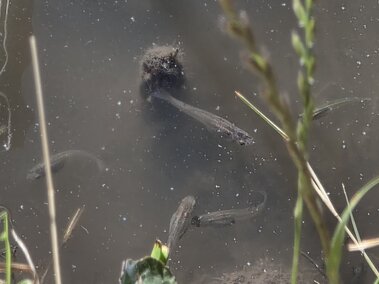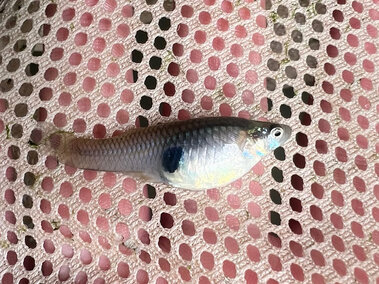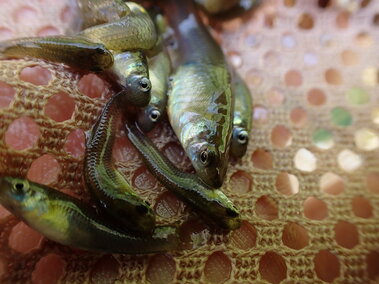General Information
Species Name: Gambusia affinis
Also Known As: mosquitofish
Family: Poecilidae (Livebearers)
Life Span: Up to 1.5 years
Life Cycle: It is a live-bearing fish, with females brooding eggs and releasing fully developed juveniles from a brood pouch. Males mature in 18 to 56 days, and females from 18 days to 10 months, longer at low temperatures. Gestation can take 15 to 50 days. Larvae are 6-8 mm at birth and free-swimming. Multiple generations can occur within one breeding season.
Origin: New Jersey south to Florida and the Gulf of Mexico, Central United States from southern Illinois to Alabama
Injurious: No.
Category 3: Established Aquatic Invasive Species
Why Are They Invasive?
Because of their aggressive and predatory behavior, mosquitofish may negatively affect populations of small fish through predation and competition, and benefit mosquitos by decreasing competitive pressure from zoooplankton and predation pressure from predatory invertebrates. In some habitats, introduced mosquitofish reportedly displaced select native fish species regarded as better or more efficient mosquito control agents. Mosquitofish also can precipitate algal blooms when the fish eat the zooplankton grazers, or in an increase in the number of mosquitoes if the fish eat the invertebrate predators
What Do They Look Like?
Western mosquitofish have the mouth upturned and the head flattened, adaptations for feeding at the surface. They have a single dorsal fin and lack dorsal and anal fin spines. They also lack a lateral line. The scales are outlined in black, giving a cross-hatched appearance. Females are larger than males, reaching a maximum 70 mm, compared to males (51 mm), but both sexes are usually smaller. Females are often pregnant, and look pot-bellied, with a dark spot near the urogenital opening. This gravid spot grows large as embryos develop. The males have the upper 4-6 pectoral rays curved upward, for a bowed appearance. In both sexes, there is a dusky-black teardrop-shaped spot across the eyes, and one to three rows of small black spots arching across the dorsal and caudal fins
Photos
Where Do They Live?
Mosquitofish are characteristic of shallow, enclosed fresh and brackish waters, including marshes and swamps, but can occur in lagoons with salinities of 20-40 PSU. They have a wide temperature tolerance, but are limited by long cold winters in the Northern and Southern Hemispheres, with a lower temperature limit around 5 C. Upper temperature tolerances can increase with acclimation, from 32 to 43 C, as acclimation temperature increased from 5 to 35 C. They prefer shallow, slow-flowing waters, that are ~0.2 m deep. Juveniles tend to prefer densely vegetated habitats, while adults prefer open water. Western Mosquitofish are omnivorous, feeding on algae, crustaceans, worms, mollusks, tadpoles, smaller fishes, and insects. They are morphologically adapted for taking food from the surface, such as fallen insects and mosquito and midge larvae. Mosquitofish are very vulnerable to predators, including fishes, birds, snakes, and frogs. They can offset high rates of mortality by rapid reproduction.
How Do They Spread?
They were intentionally introduced to California in 1922 for mosquito control and are now well-established in the State. They are also found in Oregon, Washington, the Great Lakes, and Hawaii. These fish have been introduced around the world in an effort to control disease carrying mosquitos. They are also imported for research, as an aquarium fish, forage fish, or for bait.
How Do I Control Them?
Contact the Nebraska Game and Parks Commission to determine appropriate control methods. To prevent their spread and introduction into your waterbodies:
CLEAN your watercraft, trailer, angling gear and other equipment. Remove all aquatic vegetation and animal species from your equipment.
DRAIN your watercraft at the ramp by removing the boat plug and draining all live wells and ballast tanks.
DRY your watercraft, trailer and other equipment for at least 7 days before visiting another waterbody.
DON'T DUMP BAIT. Dispose of bait by emptying bait buckets on dry land, away from waterbodies or in a trash receptacle. Moving a live organism from one waterbody to another is illegal, even if you are planning to use the organism as bait.
DON'T LET IT LOOSE. Do not release or transport exotic or non-native fish species to new ecosystems. It is unlawful to release any aquatic species into a waterbody other than the one from which it was harvested. Doing so can promote the spread of AIS.
What Should I Do If I See Them in Nebraska?
If you see western mosquitofish in Nebraska, you should report them to the Nebraska Game and Parks Commission's Aquatic Invasive Species (AIS) Program using their AIS Report Form. For guidance on what information to include in your report, check out our reporting tips.
References and More Information
Benton County Mosquito Control
Center for Invasive Species and Ecosystem Health
Nebraska Game and Parks Commission
